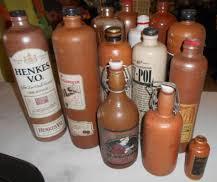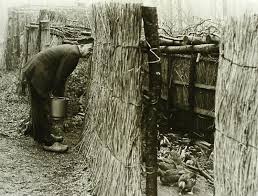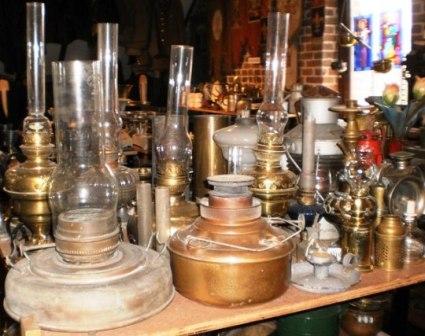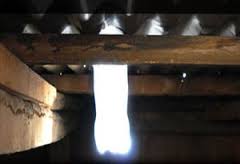Oil yield per crop
Hoeveel olie kun je persen van één kilo oliehoudende zaden of noten?
De hoeveelheden zijn bij benadering, afhankelijk van standplaats, ondergrond, ondersoorten, het weer enz.
| van 1 KILO | van 1 KILO | ongeveer |
| Zonnebloemzaad (gestreept, weinig olie) | Helianthus annuus | 0,0 liter |
| Sojaboon | Glycine max | 0,1 liter |
| Saffloer | Carthamus tinctorius | 0,2 liter |
| Olijven | Olea europaea | 0,2 liter |
| Wonderboom noot (niet ontschorst) | Moringa oleifera | 0,2 liter |
| Beukenootjes | Fagus sylvatica | 0,3 liter |
| Chia zaad | Salvia hispanica | 0,3 liter |
| Hennepzaad | Cannabis sativa subsp. sativa | 0,3 liter |
| Thee boomzaad | Camellia oleifera | 0,3 liter |
| Zwarte netel | Perilla frutescens | 0,3 liter |
| Lijnzaad | Linum usitatissimum | 0,4 liter |
| Deder (huttentut, vals vlas of cameline) | Camelina Sativa L. | 0,4 liter |
| Niger zaad (of Gingellikruid) | Guizotia abyssinica | 0,4 liter |
| Pistache | Pistacia vera | 0,4 liter |
| (Olie)pompoenzaad | Cucurbita pepo subsp. Pepo | 0,4 liter |
| Purgeernoot (niet ontschorst) | Jatropha curcas | 0,4 liter |
| Raapzaad / Canola | Brassica napus | 0,4 liter |
| Zonnebloemzaad (zwart oliezaad) | Helianthus annuus | 0,4 liter |
| Argan (olierijke boomzaden) | Argania spinosa L. | 0,5 liter |
| Cacaobonen | Theobroma cacao | 0,5 liter |
| Palmolie kernel | Elaeis guineensis | 0,5 liter |
| Pinda / aardnoot | Arachis hypogaea | 0,5 liter |
| Sesamzaad | Sesamum indicum | 0,5 liter |
| Amandel | Prunus dulcis | 0,6 liter |
| Hazelnoot | Corylus avellana | 0,6 liter |
| Babassu (Zuid-Am. Palm) | Orbignya phalerata | 0,7 liter |
| Kokosnoot (vruchtvlees) | Cocos nucifera | 0,7 liter |
| Okkernoot | Juglans sp | 0,7 liter |
| Purgeernoot (vr biodiesel, ontschorst) | Jatropha curcas | 0,8 liter |
Vroeger waren er opeenvolgende persingen om de temperatuur van pulp en olie onder de 33°C te houden. Tegenwoordig werken industriële persen met een druk tot 300 à 400 bar. Daardoor is de term “eerste koude persing” voor de Extra Vierge olijfoliën achterhaald.
Stoneware: from glass - to earthen bottle
Besides glass- there are also stone bottles. Or actually stoneware bottles. These jars or stoops (Dutch word) are predominantly known as packing for gin. It therefore is possible to make without glass (based on sand) bottles of clay. The unified shape makes it clear that they are not thrown, but cast. But how does that work? A stoop was also a measure of capacity of about 2.4 liters. In one stoop went two ‘mingel’ or 2½ can.
A stoop was also a measure of capacity of about 2.4 liters. In one stoop went two ‘mingel’ or 2½ can.
To make stoneware suitable (stoneware) clay is needed. Which can be found in the Rhine and Meuse region. Grès is the French word for stoneware, sometimes recognizable in the naming of tiles and vitrified clay pipes for sewers. Cologne was the most renowned production and distribution center. In addition, also Raeren, Frechen (and Maastricht) are known. Stoneware is designated by the name of the city or area in which it was manufactured.
From the color of the shard is sometimes seen the place of origin of the clay. Which is yellowish for the Meuse. Raeren, Frechen and Cologne stoneware have a dark gray paste while the salt glaze is evenly brown.
Stoneware bottles were originally thrown. Customers took their own neutral bottle, sold by itinerant German traders, back to the distillery. Other jars were used for mineral water, until in the middle of the 19th century everywhere waterworks were established.
Bols made the jugs world known. Between 1852 and 1879 they were made by hand and given a 'blind stamping' with the brand name. Thereafter, they were machined to 1914, followed by a hand-fixed traditional ear. Because this could not be done by machine, the ear disappeared completely in 1918.
Stoneware occurs around the last quarter of the 13th century. From the 16th century, one could control the heat in large ovens good enough. Firing took several days. It was day and night burning. The temperature should be at least 1250° Celsius.
Only in the 14th century stoneware was given a salt glaze. Salt evaporated at 1250°. So to test the temperature the potter sprinkled a little salt in the oven. Thereafter, the oven was "salted". For this one scattered (about 400 kg), salt (NaCl) through the openings of the oven.
This sodium chloride will change during the baking in sodium oxide and hydrochloric acid. This comes as a hydrochloric acid gas in white clouds out of the oven. The fumes strike down as sodium aluminum silicates. So the clay is sintering, after salt or soda has been added to the baking process. Soda from salt binds to silica from clay during the biggest heat.
On reduction fire the furnace will be closed at the proper temperature so that no oxygen will enter. The fire retrieves the oxygen it needs to burn than out of the stoneware, causing it to be even stronger. In addition also come unhealthy chlorine gas.
Salt Glaze is transparent, but coloring by additives.
Reduction firing until the end gives a gray tint. By allow fresh air at the end the pieces become brown.
The glazed and fried pitchers were suitable for liquor and even for sour lime juice that served on long sea voyages to prevent scurvy by a vitamin C deficiency.
The jars were stacked one on another in the oven. In order to avoid that they were fired together were between two layers small, sand-covered clay platelets placed. In Raeren they were called "Krätzchen". They could be used only once. Then they were recycled as floor tiles.
Approximately 30% of the content had burn marks, a failed glaze, was distorted or wrong discolored. Misfires arrived in the shards pits or in the walls of new furnaces.
The uniform production used plaster molds. A mold may be made by applying a (e.g. rotated) model in a wooden box. Fill that for 1/2nd with plaster (CaSO4.2H2O). Leave everywhere a solid edge of a few centimeters thick. The neck should be adjacent to the edge, as this is also the pouring opening. Extra space here can be useful as a reservoir from which is supplemented the by drying reducing mass. Use the model also to position the two parts of the mold well. Provide reliefs and recesses (knobs, and key- hole) to get both parts fit well together. You can thus create several identical molds. Taking into account the shrinkage, the model should be approximately 115% of the desired final shape.
As a plaster mold becomes clogged (sucks insufficient water from the clay) it can be cleaned with vinegar in water. Most of the molds can be used up to twice a day.
Engobe comes from French gober (swallow without chewing). Mud or clay slip is a viscous clay paste to apply a coating to dry (unfired) ceramic objects, or to adhere clay components (e.g. spout and ears in a teapot).
Casting clay is made with 350-400 grams of water per kilogram of dry clay mass. First an electrolyte is dissolved in the water, then the clay goes in. The electrolyte is an ion exchanging deflocculant as sodium carbonate (or soda) or sodium silicate (or water glass). (I will limit it here to traditional non-industrial products.) Without an electrolyte it would be difficult to pour pasta.
Too much electrolyte makes the clay unusable. Better follow a good known recipe for casting clay.
A clay particle has a negatively charged core and a positively charged outer layer which makes them stick together.
A deflocculant exchange ions with the clay particles so that electron bonds are broken and the particles repel each other and continue to slide over each other. So you get a lot of clay particles and sludge with little water.
The viscosity of the fluid may be determined by a Ford cup, a cup with a hole (4 mm) or a funnel with a small hole in which the time of deflation of a known volume is a measure of the viscosity.
Wet liquid clay with the consistency of milk shake can be poured into the mold. Cast preferably (through a sieve) along a wooden stem to the bottom, so that there are no splashing droplets drying too early higher on the wall. A little vibrating drives the air bubbles out. The plaster absorbes the liquid and thickens the clay like a smooth skin at the wall. Fill and add some molding clay when the level decreases because the plaster derives water of the clay. You may cut a little pouring edge off in order to check the thickness.
After 20 to 25 (sometimes up to 60!) minutes, the remaining clay sludge is poured out. (With porcelain clay already after 3 to 10 minutes.) Pour slowly, without ‘clucking’: this would suck air from inside and can distort the fragile shell.
The next day you can take the leather hard form out of the mold. First cut off the pouring edge. Due to the shrinkage during drying, the jar comes off the mold by itself. Then you can smooth and polish the outer edges and seams. (And possibly press a mark.) Then continue to dry to fire later.
The timing between filling and emptying determines the wall thickness (3-8mm). The drying in the mold determines whether the bottle is sturdy enough to get out of the moltand able to stand independently. Starting from a dry (!) plaster molt and identical clay-water mixtures you need to figure this out by experiment. (Many factors play a role: composition, temperature, ...)
(The principle for direct casting of forms with appropriate materials is also used for bronze and glass.)
Before the mechanical production of glass bottles stoneware jugs were cheaper than glass.
Strange old jobs
Urine specialist: pee was vital in the production of textiles, chemicals and gunpowder. Hence, experts would oversee the quality of the collected precious commodity.
 Leech collector : the easiest procedure was walking into a river with bare legs and letting them suck your blood until they fell off.
Leech collector : the easiest procedure was walking into a river with bare legs and letting them suck your blood until they fell off.
Bowling alley pin setter: teenage job before automation.
Knocker-upper: before alarm clocks they knocked on windows with canes and pea shooters in an attempt to wake up their clients who needed to get to work early.
Log driver: before trucks, they guided freshly cut timber floating down rivers, standing/walking on them.
Toshers someone who scavenges in the sewers to find rich pickings
Mudlarks were dredging the banks of the Thames in the early morning when the tide was out, to pick up anything valuable.
A whipping boy (1600s and 1700s) was assigned to a young prince and punished when the prince misbehaved. They grew up together since birth, they usually formed an emotional bond. And that even made it work.
A gong farmer or gongfermor (Tudor England) removed human excrement from privies and cesspits. Gong is another word for dung. They were only allowed to work at night. The waste they collected was known as night soil. It was used on the farms outside the town.
The stercorarius (Roman times) traveled door to door collecting all the human waste and cart it off to the edge of town. Farmers would buy the dung for their crops. so the Romans had a closed cycle, a better way of dealing with their waste then we now.
The urinatores were salvage divers from Ostia. The name is probably was given because deep diving caused pressure on their abdomens making them urinating a lot. They had but one tool: a kettle shaped diving bell filled with air for breathing and weighed down with lead weights. So they reached up to 30 meters below the surface. Urinatores primarily did salvage but also moved construction equipment around. It was a dangerous job, but well paid. Many became affluent members of Roman society.
Lamp lighters went around lighting or extinguishing street lamps (gas).
Previously, it was better than now, but fortunately that is over. (Piet Theys)
Alternative film
In many households is quite a bit of plastic wrap (cling film, aluminum foil and / or food wrap) used to protect food (leftovers) somewhat against decay and drying out, or to keep ex. cheese odors to the subject.
Very useful, but it is especially not environmentally friendly waste, which moreover is not recycled in practice.
In the first half of the last century, "tinfoil" was not made of aluminum, but of a tin alloy called stanniool (hence the English name tinfoil). In Flanders and the southern Netherlands it was raised for 'missions'. Fathers Scheutists claim that it was melted for reuse. But there is no trace of evidence for this story.
A centuries useful alternative to aluminum foil and cellophane wrap is a bee's wax cloth or Bee’s wrap. A natural and environmentally friendly product. And without risk of plasticizers, etc. which migrate of the plastic into our food.
Of course, a pot with a lid, or a bowl with a dish on it is also perfectly usable. Or a bread box. But sometimes an alternative is handy to cover a pot, or pack a sandwich.
The idea is simple. Take a linen or cotton cloth, and impregnate it with wax. As you make textile waterproof. Given the low melting temperature of the wax it is hardly a problem.
You can warm beeswax in a bain Marie. The cloth you should preheat on the stove, in the oven or with an iron. Then you can 'paint’ wax on / in it.
Another method is grating the wax to be spread over the canvas, and then put it in the oven to melt and continue with spreading, brushing it.
You can roll up ready-made wraps and store them for use. After use, you can wash them with cold water. Use perhaps a mild, natural soap. A beeswax cloth can be used for a month or 10. Then you can possibly repeat the procedure. Or melt the wax out for candles.
Given the risks of mold and bacteria to transfer you better do not use it, or only once, to wrap moist vegetables, meat or fish.
To make wax smoother is often added some jojoba oil (at room temperature liquid wax from the seeds of the jojoba bush (Simmondsia Chinensis). And / or some resin (wound fluids from conifers). Both products would brake and slow down the development of mold and bacteria.
In Anglo-Saxon countries the Bee’s wraps are found in different sizes in the market.
A worthy alternative to single-use industrial produced environmentally harmful waste.
Alternative film
In many households is quite a bit of plastic wrap (cling film, aluminum foil and / or food wrap) used to protect food (leftovers) somewhat against decay and drying out, or to keep ex. cheese odors to the subject.
Very useful, but it is especially not environmentally friendly waste, which moreover is not recycled in practice.
In the first half of the last century, "tinfoil" was not made of aluminum, but of a tin alloy called stanniool (hence the English name tinfoil). In Flanders and the southern Netherlands it was raised for 'missions'. Fathers Scheutists claim that it was melted for reuse. But there is no trace of evidence for this story.
A centuries useful alternative to aluminum foil and cellophane wrap is a bee's wax cloth or Bee’s wrap. A natural and environmentally friendly product. And without risk of plasticizers, etc. which migrate of the plastic into our food.
Of course, a pot with a lid, or a bowl with a dish on it is also perfectly usable. Or a bread box. But sometimes an alternative is handy to cover a pot, or pack a sandwich.
The idea is simple. Take a linen or cotton cloth, and impregnate it with wax. As you make textile waterproof. Given the low melting temperature of the wax it is hardly a problem.
You can warm beeswax in a bain Marie. The cloth you should preheat on the stove, in the oven or with an iron. Then you can 'paint’ wax on / in it.
Another method is grating the wax to be spread over the canvas, and then put it in the oven to melt and continue with spreading, brushing it.
You can roll up ready-made wraps and store them for use. After use, you can wash them with cold water. Use perhaps a mild, natural soap. A beeswax cloth can be used for a month or 10. Then you can possibly repeat the procedure. Or melt the wax out for candles.
Given the risks of mold and bacteria to transfer you better do not use it, or only once, to wrap moist vegetables, meat or fish.
To make wax smoother is often added some jojoba oil (at room temperature liquid wax from the seeds of the jojoba bush (Simmondsia Chinensis). And / or some resin (wound fluids from conifers). Both products would brake and slow down the development of mold and bacteria.
In Anglo-Saxon countries the Bee’s wraps are found in different sizes in the market.
A worthy alternative to single-use industrial produced environmentally harmful waste.
Oil Lamp: raise your light
A kerosene lamp gives light (and heat) by burning kerosene (or paraffin. Actually petroleum based material, but the terms are used interchangeably.) They followed up in 1859 the oil lamp. The lamp has a cotton stocking that is in the oil and which thus sucks up oil by capillary action. A piece of tubing can be rotated between an iron casing up or down, so that the flame burns larger or smaller.
 In 1783 the Frenchman Aimé Argand improved the burner. He used a flat piece of woven cotton between two copper tubes in a cylinder, a hollow wick. The supply of oxygen to the flame was thereby optimal. The lamp gave the light of twenty candles.
In 1783 the Frenchman Aimé Argand improved the burner. He used a flat piece of woven cotton between two copper tubes in a cylinder, a hollow wick. The supply of oxygen to the flame was thereby optimal. The lamp gave the light of twenty candles.
The lamp was further enhanced by the Frenchman Quinquet, who placed a chimney glass around the flame.
As a result, the air is compressed by a constriction, so that the oxygen penetrates even better to the flame.
As the temperature in the chimney glass becomes higher, the flame will also be larger. Note the color of the flame and turn the wick if needed a litle back.
A mantle contains some metallic oxides which when heated emit a lot of light in the visible spectrum, and low infrared. For this purpose, oxides of the lanthanides and chemically somewhat related actinides, such as cerium, and thorium are used. The wick consists of a network of synthetic fibers, saturated with these metal oxides. In the first heating the fibers burn away and remain a ”mesh” of metal left behind.
The light bulb did not originate from the continuous improvement of the candles.
Sunlight lamp
 In 2002, the Brazilian Alfredo Moser filled a PET bottle full of water and a few tablespoons of bleach (to prevent algae growth) and fitted it with waterproof resin in a corrugated iron roof. The half that protrudes above the roof catches sunlight, which is reflected in the lower half over 360 degrees. In closed houses and lofts, without electricity, you get so a lamp with a brightness of 40 to 60 watts.
In 2002, the Brazilian Alfredo Moser filled a PET bottle full of water and a few tablespoons of bleach (to prevent algae growth) and fitted it with waterproof resin in a corrugated iron roof. The half that protrudes above the roof catches sunlight, which is reflected in the lower half over 360 degrees. In closed houses and lofts, without electricity, you get so a lamp with a brightness of 40 to 60 watts.
The Filipino MyShelter Foundation has, like many other countries, copied the solar bottle bulb and spread further.
Light travels at a speed of 300 km / sec, it is strange that it does not even goes out at that speed.
